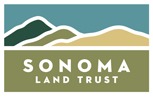JENNER INFORMATION KIT
Where is the Jenner Headlands property located?
On the Sonoma Coast, on the north side of the Russian River, above the town of Jenner and east of Highway One.
From whom was the property purchased?
Sonoma Coast Associates, Russian River Redwoods and Gualala Redwoods, Inc.
Who now owns the land?
The Sonoma Land Trust owns and will manage the property on an interim basis for 5–10 years, and the Sonoma County Agricultural Preservation and Open Space District will hold a perpetual natural resource conservation easement over it. The District and the other funding partners will continue to be involved in the property’s protection and management until an appropriate land agency is able to take title.
Why is it important to protect the Jenner Headlands?
The Jenner Headlands is located adjacent to more than 13,000 acres of Sonoma Coast State Park (visited by more than three million visitors each year); this acquisition would bring the number of protected acres on the Sonoma Coast to nearly 20,000 and create more than 30 miles of a relatively unbroken stretch of preserved land from Bodega Head to Fort Ross. It is a spectacular scenic resource,visible from Highway One, Goat Rock, Pomo Canyon Trail and Willow Creek, and to paddlers on the Russian River. On a clear day, you can see as far as Point Reyes and Mount Diablo from the Jenner Headlands. There are eight watersheds within the Headlands, including Jenner Gulch, Russian Gulch and Sheephouse Creek, all priority creeks for steelhead trout. Sheephouse Creek is also one of several creeks in Sonoma County used by the Department of Fish & Game for its coho salmon reintroduction program. Also vitally important, protecting these watersheds protects the water supply for the town of Jenner. There is significant opportunity for public access on this property, including the building of a safe 2.5-mile stretch of the California Coastal Trail. The 5,630 acres of intact, complex habitats include more than 1,500 acres of coastal prairie (an under-protected habitat type), 3,100 acres of coastal redwood and Douglas-fir forest, riparian forest, oak woodland, natural grasslands and seasonal wetlands. Connecting this property with the existing and extensive public lands will create a larger, contiguous block of wildlife habitat and corridors. These connections will also provide a buffer to help species adapt to the effects of climate change.
What are the known wildlife species of special concern?
There are 10 endangered or threatened species on the property: northern spotted owl, burrowing owl, American peregrine falcon, osprey, bank swallow, California red-legged frog, foothill yellow-legged frog, California red tree vole, steelhead trout and coho salmon.
How much did the project cost and how was it funded?
The financial support for this $36 million acquisition was provided through grants and loans from the following agencies and organizations:
- Sonoma County Agricultural Preservation and Open Space District ($9.15 million);
- National Oceanic and Atmospheric Administration’s Coastal and Estuarine Land Conservation Program ($5.85 million);
- USDA Forest Service, Forest Legacy Program ($1 million);
- Gordon and Betty Moore Foundation ($4 million); and
- The Wildlands Conservancy, Save the Redwoods League, and the David and Lucile Packard Foundation, which provided bridge loans totaling $16 million to make the acquisition possible in advance of anticipated grant funds from the State Coastal Conservancy and Wildlife Conservation Board.
In addition to funding the acquisition, the Gordon and Betty Moore Foundation and the Sonoma County Agricultural Preservation and Open Space District have agreed to contribute $2 million and $1 million, respectively, to support the Land Trust’s management, stewardship and public access activities. Individual donors to the Sonoma Land Trust have also played a significant role in making this purchase possible.
What would have happened if this land isn’t protected?
There were more than 40 existing Certificates of Compliance on the property that entitled the previous landowners to sell the lots without additional subdivision approvals from the County. Once fragmented, the opportunity to protect this large, intact ecosystem would have been lost forever.
What will public access look like?
For the next one to two years, the Sonoma Land Trust will conduct assessments of the property’s natural resources and develop a comprehensive resource management plan for the property. During this time, guided hikes will be offered regularly by the Land Trust and its recreational partners on the coastal portion of the property beginning in January, 2010. Throughout this initial phase, ways to provide broader, multi-use access will be explored. Ultimately, the property will also provide a 2.5 mile segment of the California Coastal Trail.
What kind of stewardship will the Land Trust carry out?
The primary goal of the project is to protect, enhance and restore the significant ecological resources on the property. With that as our objective, the Land Trust will manage the land to enhance the coastal prairie, redwood/Douglas fir forest, oak woodlands, open meadows, riparian corridors and instream habitats. On-the-ground projects will include efforts to control erosion (roadwork, fencing, gulley restoration), maintain the vegetation for fire control and to support native species and wildlife, restore the old-growth characteristics of the forest through sustainable forestry — which will also provide supplemental income for managing the property, and provide public access to this spectacular land.
If the Jenner Headlands is the single largest conservation land acquisition in Sonoma County, what are the next largest acquisitions?
Other large land conservation acquisitions include Austin Creek State Recreation Area, currently at approximately 5,620 acres, and Annadel State Park, at approximately 5,070 acres. In both these cases, however, portions were added over time to augment the acreages. Possibly the biggest single fee title transaction prior was the fee title portion of Willow Creek, which was 3,373 acres.
